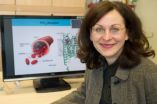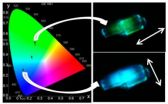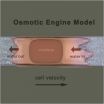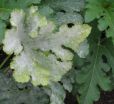(Press-News.org) An international team of researchers in cooperation with the University of Bonn has taken two "snapshots" of a receptor which are of critical importance for blood coagulation. The scientists now hope to be able to develop novel drugs using these results. These include tailor-made blood-thinning substances for heart attack and stroke patients whose effects are reversible and better controllable than those of current therapies. The researchers are presenting their results in the renowned journal "Nature."
After a cut to the finger, blood platelets come into play: they adhere to one another and thus close the wound. The adenosine diphosphate receptor P2Y12, found on the surface of platelets, plays an important role in this essential mechanism. It belongs to the family of so-called G-protein-coupled receptors (GPCR); two American researchers were awarded the Nobel prize in 2012 for research involving these receptors. "If adenosine diphosphate (ADP) binds to the receptor, signals are transmitted to the inside of the cell which will finally lead to platelet aggregation," said Prof. Dr. Christa Müller from the Pharma-Center of the University of Bonn. In this process, the receptor and its binding partner ADP fit together precisely like a lock and a key. "The ADP can be thought of as a key which unlocks the receptor (the "lock") to allow the signal for platelet aggregation to pass," explains the pharmacist.
Better control through a reversible blockade
However, platelet aggregation is sometimes undesired. For example, in the case of a heart attack or a stroke aggregated platelets occlude important blood vessels. As a preventive medicine blood thinners are generally prescribed to such patients, in order to prohibit further damage due to occluded blood vessels. Pills containing the drug clopidogrel, that must be initially activated in the liver, are of great importance, since it blocks the P2Y12 receptor and thus prevents platelet aggregation. Since clopidogrel is an irreversible inhibitor, only with the formation of new platelets after approximately one to two weeks, this effect subsides in the patients.
"An effective, direct, reversible blockade of the receptor would be desirable to be able to better control aggregation and prevent overdose," said Prof. Müller. Also, if a patient treated with clopidogrel meets with an accident, a drug which can quickly detach from the receptor would be advantageous. This would prevent the injured patient from hemorrhaging due to the previously administered blood thinner. Such drugs are being developed, but so far all of them appear to show unwanted side-effects.
Two "snapshots" show the mode of operation of the receptor
"To date, it has not been understood well how exactly the receptor works according to the lock-and-key principle," stated Prof. Müller. "However, this is an important precondition for developing such a reversible, highly effective and, at the same time well tolerated drug with few adverse effects, for the prevention of platelet aggregation." In an international team under the direction of Chinese colleagues from Shanghai and together with US researchers from Bethesda and La Jolla, the pharmacist was able to take two "snapshots" of the receptor with the help of X-ray structural analysis: once in the "unlocked" state, when a suitable binding partner ensures signal transmission in the platelet. The other shot shows the P2Y12 receptor in the blocked – "locked" – state. This shot has recently been published online in a "Nature" publication.
Both publications will appear in the printed edition of "Nature" in direct succession. "Using these two images, we can now envisage how the receptor protein's conformation is changed during unlocking," said Prof. Müller. This knowledge will also allow the design of new drugs, which selectively and reversibly block the receptor.
"However, further intensive research is needed until such new drugs will come onto the market," said the pharmacist from the University of Bonn. Since there are many receptors with very similar properties, the research into the P2Y12 receptor gives hope for other applications. Thus the related P2Y2 receptor is, for example, involved in the metastasis of tumor cells. "Here, too, new options for cancer research could arise," said the pharmacist with an optimistic view towards the future.
INFORMATION:
Publications
Agonist-bound structure of the human P2Y12 receptor, journal "Nature", DOI: 10.1038/nature13288
Structure of the human P2Y12 receptor in complex with an antithrombotic drug, journal "Nature", DOI: 10.1038/nature13083
Contact information:
Prof. Dr. Christa E. Müller
Pharmaceutical Institute
of the University of Bonn
Tel. ++49-228-732301
E-Mail: christa.mueller@uni-bonn.de
Hope for better drugs to treat stroke and heart attacks
A team of researchers in cooperation with the University of Bonn decodes a central receptor for blood coagulation
2014-04-30
ELSE PRESS RELEASES FROM THIS DATE:
Should the EU ban on the import of seal products stand?
2014-04-30
Next month, following an appeal by Canada and Norway to overturn the EU ban on the import of seal products, the World Trade Organization (WTO) is expected to announce whether the 2013 decision will be upheld. In an editorial article, a University of Bristol academic, whose research on the animal welfare of the seal hunt has been used in the case, explains why the ban should stand.
The article by Dr Andy Butterworth, Senior Lecturer in Animal Sciences at the University of Bristol's School of Veterinary Sciences and an official observer of the seal hunt is published in ...
Prostate cancer and blood lipids share genetic links
2014-04-30
Numerous studies have suggested a relationship between cardiovascular disease risk factors and prostate cancer. A new study by researchers at the University of California, San Diego School of Medicine, with colleagues in Norway, significantly refines the association, highlighting genetic risk factors associated with low density lipoprotein (LDL) cholesterol and triglycerides as key players and identifying 17 related gene loci that make risk contributions to levels of these blood lipids and to prostate cancer
The findings, published in the April 30, 2014 online issue of ...
New hybrid material that changes colour according to the direction of the light
2014-04-30
This news release is available in Spanish. The aim with respect to hybrid materials with one organic component and another inorganic one is to combine the best attributes of each one into a single system. Labs across the world are working to develop new hybrid materials for technological applications in nanotechnologies, in particular, and these materials are already being used in lightweight materials for cars, sports equipment, in biomimetic materials, like prostheses, etc.
The hybrid material being sought after by the research group in the Department of Physical ...
Neanderthals were not inferior to modern humans, says CU-Boulder study
2014-04-30
The embargo has been lifted for the article, 'Neandertal Demise: An Archaeological Analysis of the Modern Human Superiority Complex.'
If you think Neanderthals were stupid and primitive, it's time to think again.
The widely held notion that Neanderthals were dimwitted and that their inferior intelligence allowed them to be driven to extinction by the much brighter ancestors of modern humans is not supported by scientific evidence, according to a researcher at the University of Colorado Boulder.
Neanderthals thrived in a large swath of Europe and Asia between about ...
Columbia engineers grow functional human cartilage in lab
2014-04-30
New York, NY—April 30, 2014—Researchers at Columbia Engineering announced today that they have successfully grown fully functional human cartilage in vitro from human stem cells derived from bone marrow tissue. Their study, which demonstrates new ways to better mimic the enormous complexity of tissue development, regeneration, and disease, is published in the April 28 Early Online edition of Proceedings of the National Academy of Sciences (PNAS).
"We've been able—for the first time—to generate fully functional human cartilage from mesenchymal stem cells by mimicking in ...
Throwing injuries no longer just for the pros
2014-04-30
ROSEMONT, Ill.—Baseball season is back and so are the injuries. But, elbow injuries, once seen as a problem for professional athletes, are becoming more prevalent among high school and middle school athletes due to increased play and competition at the youth level. Repetitive stress to a pitcher's ulnar collateral ligament (UCL)—an important stabilizing ligament of the elbow joint—can lead to pain and eventually to the inability to pitch and throw.
According to a literature review in the May 2014 issue of the Journal of the American Academy of Orthopaedic Surgeons (JAAOS), ...
Research finds a way to protect crops from pests and disease
2014-04-30
A team of international researchers has uncovered a mechanism by which plants are able to better defend themselves against disease-causing pathogens.
The work, led by Dr Jurriaan Ton and Dr Estrella Luna at the University of Sheffield, has identified the key receptor binding a chemical called BABA (β-aminobutyric acid) which is boosting plant immunity.
BABA has long been known for its protective effects against devastating plant diseases, such as potato blight, but has so far not been used widely in crop protection because of undesirable side effects.
"We have ...
Robots may need to include parental controls
2014-04-30
Older adults' fears that companion robots will negatively affect young people may create design challenges for developers hoping to build robots for older users, according to Penn State researchers.
Companion robots provide emotional support for users and interact with them as they, for example, play a game, or watch a movie.
Older adults reported in a study that while they were not likely to become physically and emotionally dependent on robots, they worried that young people might become too dependent on them, said T. Franklin Waddell, a doctoral candidate in mass ...
Water-based 'engine' propels tumor cells through tight spaces in the body
2014-04-30
Johns Hopkins researchers have discovered a new mechanism that explains how cancer cells spread through extremely narrow three-dimensional spaces in the body by using a propulsion system based on water and charged particles.
The finding, reported in the April 24 issue of the journal Cell, uncovers a novel method the deadly cells use to migrate through a cancer patient's body. The discovery may lead to new treatments that help keep the disease in check. The work also points to the growing importance of studying how cells behave in three dimensions, not just atop flat two-dimensional ...
Frog eggs Help MU researchers find new information on grapevine disease
2014-04-30
COLUMBIA, Mo. – Vitis vinifera are common grapevines and are the world's favorite wine-producing varietal. However, research has shown that grapevines are susceptible to powdery mildew, a plant disease, which contributes to significant crop loss for most commercial wine varietals that are cultivated each year. Now, researchers at the University of Missouri have used frog eggs to determine the cause of this disease, and have found that a specific gene in the varietal Cabernet Sauvingon, contributes to its susceptibility.
"Powdery mildew disease causes the leaves of the ...
LAST 30 PRESS RELEASES:
Fat tissue around the heart may contribute to greater heart injury after a heart attack
Jeonbuk National University researcher proposes a proposing a two-stage decision-making framework of lithium governance in Latin America
Chromatin accessibility maps reveal how stem cells drive myelodysplastic progression
Cartilaginous cells regulate growth and blood vessel formation in bones
Plant hormone allows lifelong control of proteins in living animal for first time
Swedish freshwater bacteria give new insights into bacterial evolution
Global measures consistently underestimate food insecurity; one in five who suffer from hunger may go uncounted
Hidden patterns of isolation and segregation found in all American cities
FDA drug trials exclude a widening slice of Americans
Sea reptile’s tooth shows that mosasaurs could live in freshwater
Pure bred: New stem cell medium only has canine components
Largest study of its kind highlights benefits – and risks – of plant-based diets in children
Synergistic effects of single-crystal HfB2 nanorods: Simultaneous enhancement of mechanical properties and ablation resistance
Mysterious X-ray variability of the strongly magnetized neutron star NGC 7793 P13
The key to increasing patients’ advance care medical planning may be automatic patient outreach
Palaeontology: Ancient tooth suggests ocean predator could hunt in rivers
Polar bears may be adapting to survive warmer climates, says study
Canadian wildfire smoke worsened pediatric asthma in US Northeast: UVM study
New UBCO research challenges traditional teen suicide prevention models
Diversity language in US medical research agency grants declined 25% since 2024
Concern over growing use of AI chatbots to stave off loneliness
Biomedical authors often call a reference “recent” — even when it is decades old, analysis shows
The Lancet: New single dose oral treatment for gonorrhoea effectively combats drug-resistant infections, trial finds
Proton therapy shows survival benefit in Phase III trial for patients with head and neck cancers
Blood test reveals prognosis after cardiac arrest
UBCO study finds microdosing can temporarily improve mood, creativity
An ECOG-ACRIN imaging study solves a long-standing gap in metastatic breast cancer research and care: accurately measuring treatment response in patients with bone metastases
Cleveland Clinic presents final results of phase 1 clinical trial of preventive breast cancer vaccine study
Nationally renowned anesthesiology physician-scientist and clinical operations leader David Mintz, MD, PhD, named Chair of the Department of Anesthesiology at the UM School of Medicine
Clean water access improves child health in Mozambique, study shows
[Press-News.org] Hope for better drugs to treat stroke and heart attacksA team of researchers in cooperation with the University of Bonn decodes a central receptor for blood coagulation





